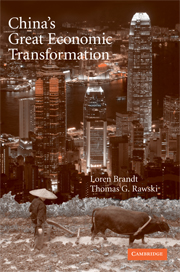Book contents
- Frontmatter
- Contents
- List of Figures
- List of Tables
- Contributors
- Acknowledgments
- Map
- 1 China's Great Economic Transformation
- 2 China and Development Economics
- 3 China in Light of the Performance of the Transition Economies
- 4 A Political Economy of China's Economic Transition
- 5 The Demographic Factor in China's Transition
- 6 The Chinese Labor Market in the Reform Era
- 7 Education in the Reform Era
- 8 Environmental Resources and Economic Growth
- 9 Science and Technology in China
- 10 The Political Economy of Private Sector Development in China
- 11 The Role of Law in China's Economic Development
- 12 China's Fiscal System: A Work in Progress
- 13 Agriculture in China's Development: Past Disappointments, Recent Successes, and Future Challenges
- 14 China's Financial System: Past, Present, and Future
- 15 China's Industrial Development
- 16 China's Embrace of Globalization
- 17 Growth and Structural Transformation in China
- 18 Income Inequality during China's Economic Transition
- 19 Spatial Dimensions of Chinese Economic Development
- 20 Forecasting China's Economic Growth to 2025
- Index
1 - China's Great Economic Transformation
Published online by Cambridge University Press: 24 May 2010
- Frontmatter
- Contents
- List of Figures
- List of Tables
- Contributors
- Acknowledgments
- Map
- 1 China's Great Economic Transformation
- 2 China and Development Economics
- 3 China in Light of the Performance of the Transition Economies
- 4 A Political Economy of China's Economic Transition
- 5 The Demographic Factor in China's Transition
- 6 The Chinese Labor Market in the Reform Era
- 7 Education in the Reform Era
- 8 Environmental Resources and Economic Growth
- 9 Science and Technology in China
- 10 The Political Economy of Private Sector Development in China
- 11 The Role of Law in China's Economic Development
- 12 China's Fiscal System: A Work in Progress
- 13 Agriculture in China's Development: Past Disappointments, Recent Successes, and Future Challenges
- 14 China's Financial System: Past, Present, and Future
- 15 China's Industrial Development
- 16 China's Embrace of Globalization
- 17 Growth and Structural Transformation in China
- 18 Income Inequality during China's Economic Transition
- 19 Spatial Dimensions of Chinese Economic Development
- 20 Forecasting China's Economic Growth to 2025
- Index
Summary
In this book, a large and diverse group of researchers pool their knowledge to take the measure of China's massive, protracted, and unexpected economic upsurge, which began in the late 1970s and continues as this is written nearly thirty years later. The magnitude and rapidity of China's recent gains stand out even against the background of stunning growth among China's East Asian neighbors during the late twentieth century.
China's extended boom began at remarkably low levels of income and consumption. Its growth spurt is remarkable for its geographic spread as well as its speed and longevity. While coastal regions have led the upward march of output, exports, and income, China's central and western regions have recorded enormous gains as well.
A brief summary can delineate the magnitude of China's recent economic achievements. One careful review of available data finds that average gross domestic product (GDP) growth increased from approximately 4 percent prior to the reform to 9.5 percent during 1978–2005 (see Chapter 20). Although Young (2003) and others label recent growth as extensive, meaning that the main motive force comes from adding more labor and capital to the production process, the same study finds that productivity improvement accelerated from 0.5 to 3.8 percent per annum after the reform, with productivity change accounting for 40.1 percent of overall GDP growth during 1978–2005, as opposed to 11.4 percent during 1952–1978 and –13.4 percent (i.e., a productivity decline) during 1957–1978 (see Table 20.2).
- Type
- Chapter
- Information
- China's Great Economic Transformation , pp. 1 - 26Publisher: Cambridge University PressPrint publication year: 2008
- 35
- Cited by



